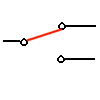My 3-way switches don't work!
You set out to replace one or both switches in a two-switch light circuit. You cannot remember how they were wired, and now things do not work.
If your light circuit has three or more switches, see instead My 4-way switches don't work.
What do you do?
First, you may find it helpful to understand how 3-way switches work to accomplish this task. See Tutorial: How 3-way and 4-way switch circuits work. Further, this discussion assumes that you have only disconnected the switches and have not removed wire nuts of any other connections inside the switch boxes.
Note that there is a 3-way switch at each end of your circuit.
We need to answer the following questions:
- For the first 3-way box, which two of the three wires attached to the original switch continue to the other 3-way?
- For the second 3-way box, which two of the three wires attached to the original switch come from the other 3-way?
- What is the wiring pattern of your 3-way switches?
You generally need two people working together answer these questions:
one with the meter on resistance, one tapping pairs of wires
together.
First, kill the circuit breaker and be sure there is no power to the circuit.
Next remove both switches.
To answer Questions 1 and 2:
Post person A at the first 3-way box and person B with the meter at the second 3-way box. B measures the resistance between various pairs of the 3 wires as A taps together various pairs of the 3 wires. When B sees the resistance alternating between zero and infinity as a pair of wires is tapped, you have identified the pair of wires going between the two boxes.
To answer Question 3:
 Find
the pair of screws that always show high resistance with the switch in either
position. Call these the "OUT" pair. The remaining screw is the "IN"
screw of the 3-way switch. Double check: the resistance from the "IN"
screw to either "OUT" screw will toggle between 0 and infinity as
the switch is flipped. Note: if one screw is a different color from the other
two, this is probably the "IN" screw. Slide your mouse of the image
of the switch at right to see how the switch works.
Find
the pair of screws that always show high resistance with the switch in either
position. Call these the "OUT" pair. The remaining screw is the "IN"
screw of the 3-way switch. Double check: the resistance from the "IN"
screw to either "OUT" screw will toggle between 0 and infinity as
the switch is flipped. Note: if one screw is a different color from the other
two, this is probably the "IN" screw. Slide your mouse of the image
of the switch at right to see how the switch works.
OK!!!!!
Now you are ready to wire the switches. Refer again to the figures on the Tutorial: How 3-way and 4-way switch circuits work page.
- In the first 3-way switch box, connect the pair of wires leading to the other box to the "OUT" pair of screws on the switch. Connect the remaining wire to the "IN" screw.
- Repeat for the other 3-way switch box.
The circuit should now work.
Send suggestions and comments to matthews@wfu.edu.
- Previous: Controlling multiple lights from multiple switches
- Main Switches Page
- Next: My 4-way switches don't work
- 3-way switches and 4-way switches, a discussion of how 3-way and 4-way switches work.
- Rick Matthews home page.
- Rick Matthews' miscellaneous tips and info.